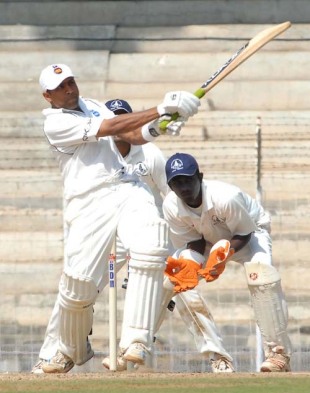|
|
|

Aakash Chopra was last season's leading run-scorer with 1339 runs in 15 first-class matches, at 60.86 and yet didn't make an appearance in BCCI's contracts list
© Cricinfo Ltd
|
|
| |
When the Indian board introduced the Grade D in the
contracts system last year, the idea was to reward and offer job security to domestic players. The contract was worth Rs 15 lakh a year, and was meant as an incentive to keep the domestic talent in the mainstream at a time when many were defecting to the ICL.
The idea is a good one, but the lack of consistency in its implementation this year has left room for plenty of questions: the selection of players doesn't follow any trend, and has some glaring omissions and inclusions. It doesn't help that the BCCI will not clarify the reasons for dropping or selecting a player - it never does, especially to the concerned players.
According to BCCI officials, the contracts selection committee picked players based on the performances in the 2007-08 domestic season. The committee in question comprised Kris Srikkanth, the chairman of national selectors, Shashank Manohar, the BCCI president, and N Srinivasan, the board secretary. If the selections were indeed based on the performances in the last season, Aakash Chopra should have been retained. He was the season's leading run-scorer with 1339 runs in 15 first-class matches, at 60.86. Similarly Karnataka's R Vinay Kumar took 47 wickets at 20.29 to end as the leading wicket-taker, but neither of those two names are in the list. Rajat Bhatia, who scored 674 runs at 48.19 and took 34 wickets at 12.47, is missing too.
And what about the performers in the IPL? Swapnil Asnodkar and Dhawal Kulkarni surprised everybody with their performance there, but have not been given contracts. Kulkarni has carried forward the Twenty20 promise into first-class cricket and is the leading wicket-taker after six rounds of Ranji Trophy this season. All this means the most successful batsman, bowler, and allrounder from domestic cricket last season, and the best performers from Twenty20 are missing from the contracts list.
The board could perhaps argue that performances in the previous season aren't the only criteria - it also needs to be convinced that the player has a future with the Indian team. So is it fair to suggest that the board has perhaps picked the 38 players who have the best chance of making it to the Indian team over the next year? A closer scrutiny of the list shows that this argument falls through as well.
Wasim Jaffer has a Grade C contract, but at 31 and after several failures at the international level, it's unlikely he's among the top names for another comeback - he has as much chance of making a return as Chopra. But Jaffer stays in Grade C, the same grade as Praveen Kumar and Yusuf Pathan, and ahead of M Vijay, who by right should be the stand-by opener for India. S Badrinath's promotion to Grade B, alongside the likes of Ishant Sharma, Suresh Raina and Rohit Sharma, is also questionable for he is yet to make his Test debut, and struggled in the games against Australia A. Wouldn't he have been better-placed in Grade C along with Amit Mishra and Yusuf, who have something to show for at the international level?
Some of the names in the Grade D raise further doubts: Manpreet Gony, Chetanya Nanda and R Ashwin have been included despite ordinary first-class displays. Gony took 13 wickets in the Ranji Trophy before impressing in the IPL, a similar case as Asnodkar and Kulkarni; Ashwin played only two Ranji games; Nanda managed 29 wickets in the season. On that count Gony, Ashwin and Nanda are not three of the best 38 players in the country. Ashok Dinda and Wriddhiman Saha are both in the list, but are they really in the reckoning for a national place? With so many names and issues to discuss, wouldn't it be better to have the whole selection committee present to discuss the contracts?
Dilip Vengsarkar, whom Srikkanth succeeded as the chairman of selectors, lashed out at these selections. "It's quite absurd that these two names [Ajinkya Rahane and Kulkarni] are not in the list as they are the leading run-getter and wicket-taker in the national championship this year. Rahane has scored more than 750 runs in Ranji this year and more than 1100 runs last year in first-class cricket," Vengsarkar was quoted as saying by PTI. "Everyone would like to know the criteria of selecting the players, as it smacks of regionalism. I hope the BCCI takes up this issue at its next working committee meeting and adds these two names to the list."
There is one big positive inclusion in the contracts - that of Sudeep Tyagi. He made a superb debut last season, but lost his way because of injury. He is yet to make a proper comeback from the back injury that kept him out of IPL. But this vote of confidence should keep his morale up.
There are still many questions that can be answered only if the BCCI reveals the criteria for handing out the contracts. Like employers in any other profession, it can choose its employees without needing to give reasons. Unlike those employers, however, the BCCI deals with cricket, the most followed sport in the country.
Sidharth Monga is a staff writer at Cricinfo

